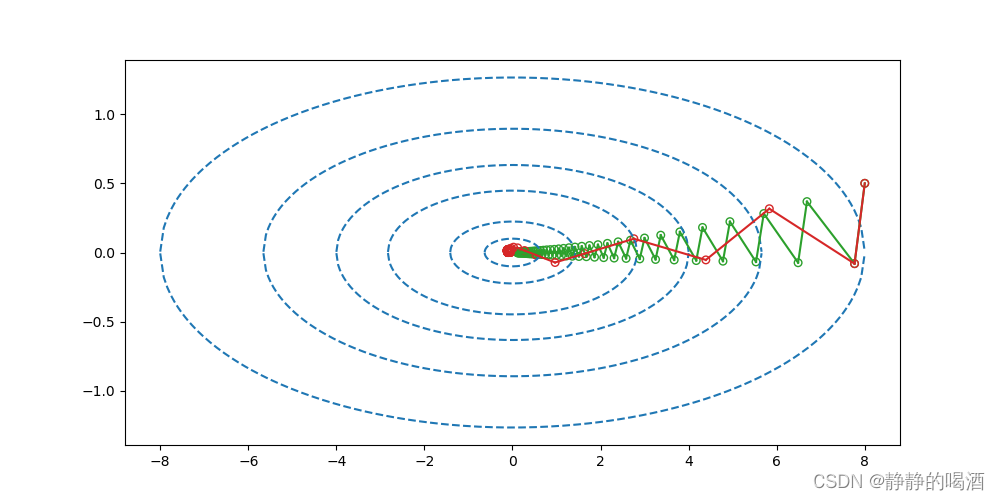蚁群算法的应用案例分析:深入剖析算法的实践价值,领略算法的魅力
发布时间: 2024-07-22 09:28:34 阅读量: 136 订阅数: 39 


# 1. 蚁群算法的理论基础
蚁群算法是一种受蚂蚁觅食行为启发的优化算法。蚂蚁在觅食过程中,会释放信息素,引导其他蚂蚁找到食物。蚁群算法模拟了这一过程,通过信息素的释放和更新,不断优化求解路径或方案。
蚁群算法的核心思想是正反馈和负反馈机制。正反馈机制使蚂蚁更倾向于选择信息素浓度高的路径,而负反馈机制则防止蚂蚁陷入局部最优解。通过这两个机制的相互作用,蚁群算法能够有效地探索搜索空间,找到全局最优解或接近最优解。
蚁群算法具有鲁棒性强、并行性好、分布式计算等优点,广泛应用于旅行商问题、车辆路径规划、网络优化等组合优化问题中。
# 2.1 蚁群算法的Python实现
### 2.1.1 基本数据结构和算法流程
蚁群算法的Python实现主要涉及以下数据结构和算法流程:
**数据结构:**
* **蚁群:**一个包含多个蚂蚁的集合,每个蚂蚁代表一个潜在的解决方案。
* **信息素矩阵:**一个表示问题空间中不同路径强度的信息素矩阵。
* **启发式信息矩阵:**一个表示问题空间中不同路径吸引力的启发式信息矩阵。
**算法流程:**
1. **初始化:**
- 随机初始化信息素矩阵和启发式信息矩阵。
- 创建一个包含多个蚂蚁的蚁群。
2. **蚂蚁移动:**
- 每个蚂蚁根据信息素矩阵和启发式信息矩阵计算其下一个移动的概率。
- 蚂蚁移动到下一个节点,并更新信息素矩阵。
3. **信息素更新:**
- 当蚂蚁完成其路径时,信息素矩阵中与其路径相关的路径强度增加。
4. **终止条件:**
- 算法在满足预定义的终止条件(例如达到最大迭代次数或找到最佳解决方案)时终止。
### 2.1.2 参数调优和性能分析
蚁群算法的性能受以下参数的影响:
* **蚂蚁数量:**蚂蚁数量影响探索和利用之间的平衡。
* **信息素挥发率:**信息素挥发率控制信息素的衰减速率,影响算法的收敛速度。
* **启发式信息因子:**启发式信息因子控制启发式信息在蚂蚁决策中的权重。
参数调优可以通过实验确定最佳参数值,以提高算法的性能。性能分析指标包括:
* **收敛速度:**算法达到最佳解决方案所需的时间。
* **解决方案质量:**算法找到的解决方案的质量。
* **鲁棒性:**算法对不同问题实例的性能。
**代码块:**
```python
import random
import numpy as np
class AntColony:
def __init__(self, num_ants, num_nodes, alpha, beta, rho):
self.num_ants = num_ants
self.num_nodes = num_nodes
self.alpha = alpha
self.beta = beta
self.rho = rho
# Initialize pheromone and heuristic matrices
self.pheromone_matrix = np.ones((num_nodes, num_nodes))
self.heuristic_matrix = np.random.rand(num_nodes, num_nodes)
# Create a list of ants
self.ants = [Ant(self) for _ in range(num_ants)]
def run(self, max_iterations):
for iteration in range(max_iterations):
# Let ants move and update pheromone matrix
for ant in self.ants:
ant.move()
ant.update_pheromone()
# Evaporate pheromone matrix
self.pheromone_matrix *= (1 - self.rho)
# Find the best solution
best_ant = max(self.ants, key=lambda ant: ant.total_distance)
return best_ant.path, best_ant.total_distance
class Ant:
def __init__(self, colony):
self.colony = colony
self.path = []
self.total_distance = 0
def move(self):
current_node = random.randint(0, self.colony.num_nodes - 1)
self.path.append(current_node)
while len(self.path) < self.colony.num_nodes:
next_node = self.select_next_node(current_node)
self.path.append(next_node)
current_node = next_node
def select_next_node(self, current_node):
probabilities = np.zeros(self.colony.num_nodes)
for next_node in range(self.colony.num_nodes):
if next_node not in self.path:
pheromone = self.colony.pheromone_matrix[current_node, next_node]
heurist
```
0
0





